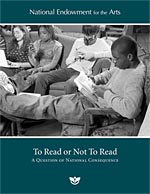 Matthew G. Kirschenbaum writes an elegant and concise critique of the National Endowment for the Arts’ ominously titled new study of American reading trends, “To Read or Not to Read: A Question of National Consequence”, which is a sequel to their 2004 opus “Reading at Risk.” The basic argument is that reading, or what they rather awkwardly refer to as “voluntary reading” (that is, reading done purely for pleasure or self-improvement) is in a precipitious state of decline, especially among the young -? a situation which poses a grave threat to our culture, democracy and civic fabric.
Matthew G. Kirschenbaum writes an elegant and concise critique of the National Endowment for the Arts’ ominously titled new study of American reading trends, “To Read or Not to Read: A Question of National Consequence”, which is a sequel to their 2004 opus “Reading at Risk.” The basic argument is that reading, or what they rather awkwardly refer to as “voluntary reading” (that is, reading done purely for pleasure or self-improvement) is in a precipitious state of decline, especially among the young -? a situation which poses a grave threat to our culture, democracy and civic fabric.
Though clearly offered with the best of intentions, the report demonstrates an astonishingly simplistic view of what reading is and where it is and isn’t occurring. Overflowing with bar graphs and and charts measuring hours and minutes spent reading within various age brackets, the study tries to let statistics do the persuading, but fails at almost every turn to put these numbers in their proper social or historical context, or to measure them adequately against other widespread forms of reading taking place on computers and the net.
The study speaks, as Kirschenbaum puts it, “as though there is but a single, idealized model of reading from which we have strayed” -? a liesurely, literary sort of reading embodied by that classic image of the solitary reader hunched over a book in deep concentration. Kirschenbaum rightly argues that this way of reading is simply one of a complicated and varied set of behaviors that have historically operated around texts. More to the point, many of these alternative forms -? skimming, browsing, lateral reading, non-linear reading, reading which involves writing (glossing, annotation etc.) to name some -? today happen increasingly in digital contexts, constituting what Kirschenbaum refers to broadly as a grand “remaking of reading.” The NEA document takes little of this into account. Kirschenbaum:
…while the authors of the report repeatedly emphasize that they include online reading in their data, the report sounds most clumsy and out of touch when referring to new media. The authors of the report tend to homogenize “the computer” without acknowledging the diversity of activity -? and the diversity of reading -? that takes place on its screen. Our screens are spaces where new forms like blogs and e-mail and chats commingle with remediations of older forms, like newspapers and magazines -? or even poems, stories, and novels. Reading your friend’s blog is not likely a replacement for reading Proust, but some blogs have been a venue for extraordinary writing, and we are not going to talk responsibly or well about what it means to read online until we stop conflating genre with value.
The report also fails to acknowledge the extent to which reading and writing have become commingled in electronic venues. The staccato rhythms of a real-time chat session are emblematic in this regard: Reading and writing all but collapse into a single unified activity. But there is a spectrum of writing online, just as there is a spectrum of reading, and more and more applications blur the line between the two.
(He goes on to mention CommentPress and a number of other networked reading applications…)
There’s certainly cause for concern about what might be lost as deep extended reading of deep extensive books declines, and in their crude way the NEA’s stats and figures do tell a worrying tale of shifting cultural priorities. Indeed, the most appealing aspect of “To Read or Not to Read” is its passionate commitment to a set of humanistic values: sustained thinking, personal and moral growth, a critical outlook, the cultivation of knowledge. Few would disagree that these are things that ought to be held onto in the face of relentless technological change and a rapacious commercial culture, but to insist that the book and one particular romanticized notion of reading must be the sole vessels for transporting these values into the future seems both naive and needlessly limiting.
You could say that our group’s mission is to advocate for these same values -? values that we certainly associate with books, hence our name -? but in the diverse landscape of new media. To the question “to read or not to read” we answer emphatically “to read!” But to understand what reading actually is demands a more nuanced investigation.
